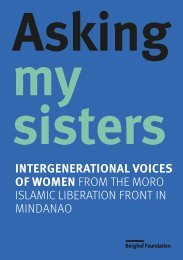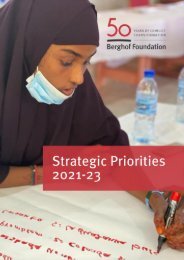Berghof Foundation: 50 years of conflict transformation
This book provides an overview of the Berghof Foundation’s work and impact over the past 50 years and sheds light on the challenges ahead of peacebuilding.
This book provides an overview of the Berghof Foundation’s work and impact over the past 50 years and sheds light on the challenges ahead of peacebuilding.
Create successful ePaper yourself
Turn your PDF publications into a flip-book with our unique Google optimized e-Paper software.
Protest movements<br />
have been very good<br />
at mobilising large<br />
social constituencies,<br />
118<br />
but encounter serious<br />
limitations when it<br />
comes to engaging<br />
effectively in interparty<br />
dialogue or<br />
reform processes.<br />
Peaceful protest movements<br />
Key drivers <strong>of</strong> <strong>conflict</strong><br />
<strong>transformation</strong><br />
As witnessed across Latin America, in the<br />
Middle East, Asia and Europe during the last two<br />
<strong>years</strong>, there is a global resurgence <strong>of</strong> nonviolent<br />
movements taking to the streets to protest against<br />
autocratic or unaccountable governments.<br />
‘People power’ campaigns for human rights, good<br />
governance and social justice are <strong>of</strong>ten catalysts<br />
for peace processes and democratic change.<br />
Research has shown that political transitions<br />
initiated by bottom-up nonviolent protest<br />
movements are more lasting, more peaceful and<br />
more democratic than other forms <strong>of</strong> transition.<br />
Starting from these findings and complementing<br />
<strong>Bergh<strong>of</strong></strong>’s longstanding work on all levels <strong>of</strong><br />
<strong>conflict</strong> <strong>transformation</strong> including grassroots<br />
movements, we study and constructively engage<br />
with social movements that pursue nonviolent<br />
protest strategies — such as demonstrations,<br />
strikes, boycotts or more symbolic forms <strong>of</strong><br />
resistance — as an alternative to violent resistance<br />
or extremism.<br />
We understand civil resistance and<br />
peacebuilding strategies to be complementary<br />
facets <strong>of</strong> <strong>conflict</strong> <strong>transformation</strong>. Protest<br />
movements prioritise justice through the<br />
empowerment <strong>of</strong> marginalised groups, while<br />
peacebuilders prioritise peace by generating<br />
mutually acceptable solutions, with the use <strong>of</strong><br />
dialogue, negotiation or reconciliation. When<br />
conducted successfully, peaceful protests<br />
can serve as effective violence prevention<br />
mechanisms; as pre-negotiation tools pressuring<br />
power-holders to engage in inclusive dialogue;<br />
and as accountability instruments in the wake <strong>of</strong><br />
peace accords and democratic transitions, by<br />
mobilising to oppose autocratic backlash or to<br />
demand full implementation <strong>of</strong> progressive state<br />
reform. These insights underline the importance <strong>of</strong><br />
understanding peaceful protest movements in the<br />
context <strong>of</strong> <strong>conflict</strong> <strong>transformation</strong> work.<br />
Working with protest<br />
movements<br />
Practical challenges<br />
Often, protest movements fail to meet their<br />
ambitious aspirations. Prominent cases such as<br />
the Arab Spring revolutions in Egypt and Syria<br />
and the 2014 Euromaidan revolution in Ukraine<br />
show that bottom-up peaceful transitions can<br />
lose momentum and ultimately result in a return to<br />
authoritarianism or even outbreaks <strong>of</strong> civil war, due<br />
to a severely repressive state forcing protesters<br />
to leave the country or imprisoning them, as well<br />
as diffuse protest leadership allowing sections<br />
<strong>of</strong> a movement to change tactics and resort to<br />
polarisation or violence.<br />
Another challenge for nonviolent<br />
movements is their marginalisation during formal<br />
negotiations or political transitions, leading to<br />
their exclusion from power or their co-optation<br />
by former political allies. In a number <strong>of</strong> recent<br />
or ongoing pro-democracy campaigns — e.g. in<br />
Sudan, Algeria and Lebanon — protest movements<br />
have been very good at mobilising large social<br />
constituencies, but encounter serious limitations<br />
when it comes to engaging effectively in interparty<br />
dialogue or reform processes.<br />
There are multiple factors contributing to<br />
this gap, including movements’ lack <strong>of</strong> strategic<br />
planning and readiness for inter-party dialogue.<br />
Protesters might be sceptical about negotiations<br />
and adopt uncompromising positions towards<br />
their opponents. Moreover, movements are<br />
<strong>of</strong>ten structured as heterogeneous coalitions<br />
that unite around demands for change, but lack<br />
a unified vision <strong>of</strong> what comes next. On the side<br />
<strong>of</strong> power-holders, governments may refuse to<br />
hold dialogues or may impose restrictions on<br />
who can represent movements. International<br />
peacebuilding agencies and mediators also <strong>of</strong>ten<br />
lack understanding <strong>of</strong> grassroots movements and<br />
fail to engage them proactively, preferring to work<br />
with the formal political opposition or selected civil<br />
society leaders.<br />
119










